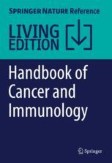Search
Search Results
-
PD-1 receptor outside the main paradigm: tumour-intrinsic role and clinical implications for checkpoint blockade
Blocking the inhibitory receptor PD-1 on antitumour T lymphocytes is the main rationale underlying the clinical successes of cancer immunotherapies...

-
Tumor Evasion of the Immune System: Role of Interferon and Tumor Necrosis Factor in Cancer
The tumor necrosis factor (TNF) and interferon (IFN) are proto- and anti-oncogene that encode for a family of transcription factors which is among...
-
Masking the immunotoxicity of interleukin-12 by fusing it with a domain of its receptor via a tumour-protease-cleavable linker
Immune-checkpoint inhibitors have shown modest efficacy against immunologically ‘cold’ tumours. Interleukin-12 (IL-12)—a cytokine that promotes the...

-
Whole tumour cell-based vaccines: tuning the instruments to orchestrate an optimal antitumour immune response
Immunotherapy, particularly those based on immune checkpoint inhibitors (ICIs), has become a useful approach for many neoplastic diseases. Despite...

-
The effects of phytochemicals and herbal bio-active compounds on tumour necrosis factor-α in overweight and obese individuals: a clinical review
Obesity is abnormal fat accumulation in the body which acts as a risk factor for various cardiometabolic states. Adipose tissue in excess can release...

-
Tertiary lymphoid structural heterogeneity determines tumour immunity and prospects for clinical application
Tertiary lymphoid structures (TLS) are clusters of immune cells that resemble and function similarly to secondary lymphoid organs (SLOs). While TLS...

-
Therapeutic targeting of tumour myeloid cells
Myeloid cells are pivotal within the immunosuppressive tumour microenvironment. The accumulation of tumour-modified myeloid cells derived from...

-
Osteoblasts and osteoclasts: an important switch of tumour cell dormancy during bone metastasis
Bone metastasis occurs when tumour cells dissociate from primary tumours, enter the circulation (circulating tumour cells, CTCs), and colonize sites...

-
Mechanisms of resistance to chimeric antigen receptor-T cells in haematological malignancies
Chimeric antigen receptor (CAR)-T cells have recently emerged as a powerful therapeutic approach for the treatment of patients with...

-
Targeting tumour-reprogrammed myeloid cells: the new battleground in cancer immunotherapy
Tumour microenvironment is a complex ecosystem in which myeloid cells are the most abundant immune elements. This cell compartment is composed by...

-
T cell receptor therapeutics: immunological targeting of the intracellular cancer proteome
The T cell receptor (TCR) complex is a naturally occurring antigen sensor that detects, amplifies and coordinates cellular immune responses to...

-
Recent advances in cancer-on-a-chip tissue models to dissect the tumour microenvironment
Three-dimensional cancer-on-a-chip tissue models aim to replicate the key hallmarks of the tumour microenvironment and allow for the study of dynamic...

-
Novel role of immune-related non-coding RNAs as potential biomarkers regulating tumour immunoresponse via MICA/NKG2D pathway
Major histocompatibility complex class I related chain A (MICA) is an important and stress-induced ligand of the natural killer group 2 member D...

-
The therapeutic age of the neonatal Fc receptor
IgGs are essential soluble components of the adaptive immune response that evolved to protect the body from infection. Compared with other...

-
Role of Tumour-Associated Macrophages in Colon Cancer Progression and Its Therapeutic Targeting
Cancer tissues are invariably infiltrated by cells of the immune system, and macrophages constitute the major portion of these. Experimental pieces...
-
Urokinase-type plasminogen activator receptor (uPAR) as a therapeutic target in cancer
Urokinase-type plasminogen activator receptor (uPAR) is an attractive target for the treatment of cancer, because it is expressed at low levels in...

-
Involvement of redox signalling in tumour cell dormancy and metastasis
Decades of research on oncogene-driven carcinogenesis and gene-expression regulatory networks only started to unveil the complexity of tumour...

-
Soluble CD27 is an intrathecal biomarker of T-cell-mediated lesion activity in multiple sclerosis
ObjectiveSoluble CD27 is a promising cerebrospinal fluid inflammatory biomarker in multiple sclerosis. In this study, we investigate relevant immune...

-
Role of C-Type Lectins in the Tumor Microenvironment
C-type lectin receptors (CLRs) represent a broad and diversified family of pattern recognition receptors (PRRs) that are mainly expressed on the...
-
Morpholino-driven blockade of Dkk-1 in osteosarcoma inhibits bone damage and tumour expansion by multiple mechanisms
BackgroundOsteosarcoma (OS) is the most common primary bone malignancy. Chemotherapy plays an essential role in OS treatment, potentially doubling...

